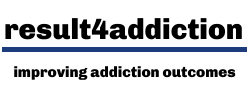Measuring addiction outcomes
There is no single measure that will adequately capture the outcome, be that from treatment or natural recovery, of people with addiction problems. Substance use might be an answer, but there is no simple way to describe all of a person’s substance use in one number. It is best to think of making up a profile by tapping into the most important problem areas.
What is a rational approach to outcome measurement?
❝Not everything that matters can be measured and not everything that is measured matters❞ from Albert Einstein
Remember that different stakeholders, service users, practitioners, commissioners will all have different priorities. A mix of these main categories of outcome measures works well. Where possible use scales that can measure clinically significant change, the gold standard of outcome measurement. It is a good idea to set out a hierarchy of measures so as not to burden service users or staff with data collection that is not essential to good practice.
-
Generic measures
Apply across a whole sector - health and social care in this case.
Examples are the Euroqol Five Dimensions (EQ5D), especially where economic outcomes are of importance, and the 10 item Clinical Outcomes in Routine Evaluation (CORE-10) psychological wellbeing scale.
Answer questions like…
✔︎ How ill are people with addiction problems compared to other users of health care?
✔︎ How complex are the health problems?
✔︎ What is the illness profile of people with addictions?
✔︎ What benefits does treatment have for society as a whole?
✔︎ Is treatment cost effective?
✔︎ What have been the wider savings achieved?
✔︎ Have there been public health gains?
-
Dimension measures
Apply across a whole speciality or field - addiction in this case.
Examples are the Addiction Recovery Questionnaire (ARQ), which is also a treatment planning tool, and substance use itself, which is usually expressed as some combination of quantity and frequency.
Answer questions like…
✔︎ How severe is the addiction?
✔︎ How problematic are the different elements of the addiction?
✔︎ How difficult is treatment likely to be?
✔︎ Do problems persist after treatment?
✔︎ How good is one addiction service compared to another?
-
Condition specific measures
Rate the severity or stage of a particular problem or disorder.
Examples are the Leeds Dependence Questionnaire (LDQ), a measure of dependence; the Patient Health Questionnaire (PHQ9) and Generalised Anxiety Disorder (GAD7) for anxiety and depression.
Answer questions like…
✔︎ How severe is the specific addiction related diagnosis or problem?
✔︎ How effective is treatment for this specific problem?
✔︎ How do services targeting the condition compare?
The list of condition specific measures is limited only by the range of addiction related disorders or problems. Common examples are: substance dependence, mental health problems, accidents, family functioning, addiction related physical health problems.
-
Societal impact measures
Typically not scales, rather bits of information which may be of note for a particular kind of service and often wanted by politicians and managers. Hospital attendances, overdoses and arrests are examples.
Answer questions like…
✔︎ How many attendances at A&E?
✔︎ How many attendances at primary care clinics?
✔︎ What are the costs of prescribing?
✔︎ What are the rates of offending?
✔︎ Who receives payment of benefits?
The list of societal impact measures is limited only by the possible social questions.
RESULT profile: best minimum dataset measures…
Substance Use is the measure most readily understood by stakeholders who are not practitioners. Simply asking the frequency of use is a very good way to profile substance use, but some people like to use screening tools such as AUDIT and DUDIT.
Leeds Dependence Questionnaire, LDQ is a determinant of the substance use goal, the intensity of intervention likely to be needed, and an indicator of relapse risk
Clinical Outcomes in Routine Evaluation, CORE is a screening tool for mental illness, a measure of current psychological distress, and a screen for self-harm/suicide
Addiction Recovery Questionnaire, ARQ is a treatment planning tool and an indicator of quality of life across the 12 areas rated
The minimum dataset can be supplemented with ‘condition specific’ measures and ‘societal impact’ measures as required. The charts demonstrate what can be achieved with the RESULT outcomes profile…
Choosing outcome measures - scientific articles
Fitzpatrick R, Davey C, Buxton MJ and Jones DR (1998) Evaluating patient-based outcome measures for use in clinical trials
Shorter GW, Heather N, Bray JW, Berman AH, Giles EL, O’Donnell AJ, Barbosa C, Clarke M, Holloway A and Newbury-Birch D (2019) Prioritization of Outcomes in Efficacy and Effectiveness of Alcohol Brief Intervention Trials: International Multi- Stakeholder e-Delphi Consensus Study to Inform a Core Outcome Set Journal of Studies on Alcohol and Drugs 80: 299-309
More pages about outcomes measurement…
Check out these measures of: substance use, dependence, recovery, wellbeing, mental health and governance







